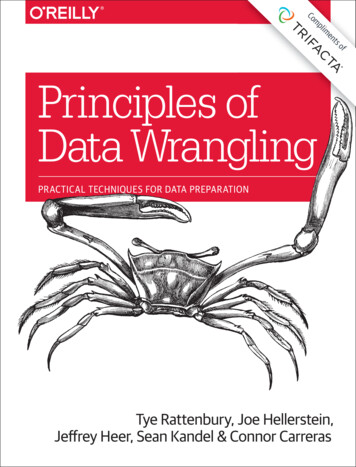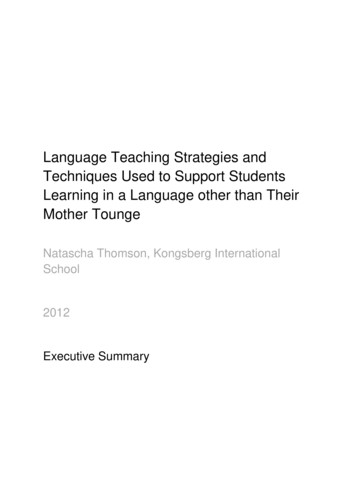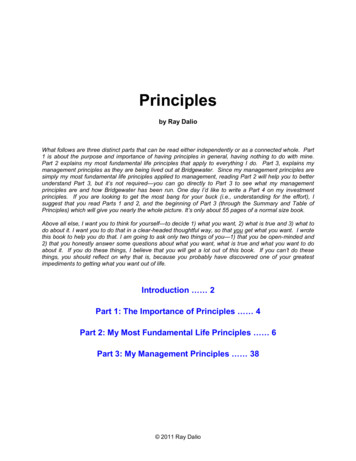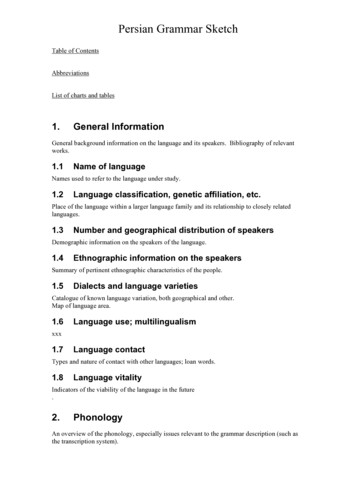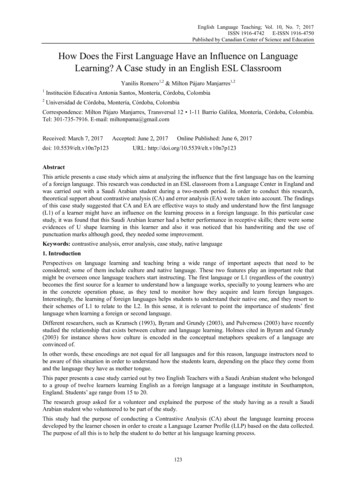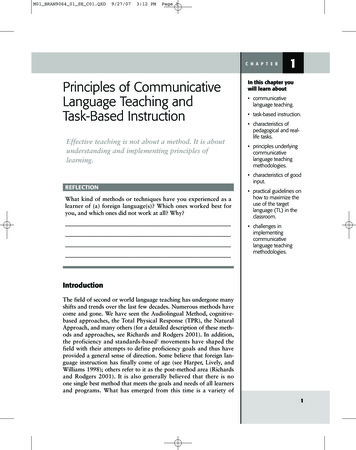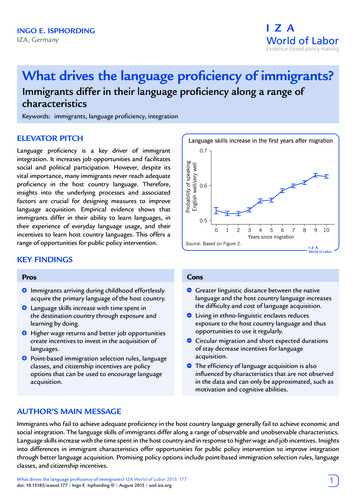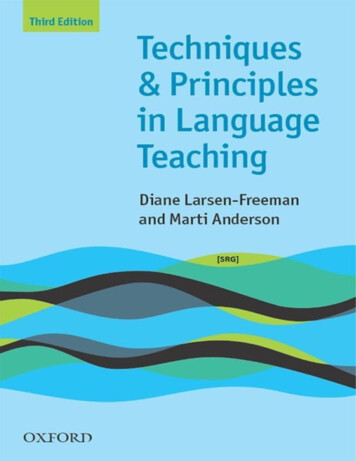
Transcription
Third Edition
Techniques& Principlesin LanguageTeachingDiane Larsen-Freemanand Marti Anderson
Great Clarendon Street, Oxford 0X2 6DPOxford University Press is a department of the University of Oxford.It furthers the University’s objective of excellence in research,scholarship, and education by publishing worldwide inOxford New YorkAuckland Cape Town Dar es Salaam Hong Kong KarachiKuala Lumpur Madrid Melbourne Mexico City NairobiNew Delhi Shanghai Taipei TorontoWith offices inArgentina Austria Brazil Chile Czech Republic France GreeceGuatemala Hungary Italy Japan Poland Portugal SingaporeSouth Korea Switzerland Thailand Turkey Ukraine VietnamOXFORD and OXFORD ENGLISH are registered trade marks ofOxford University Press in the UK and in certain other countries Oxford University Press 2011The moral rights of the author have been assertedDatabase right Oxford University Press (maker)First published 20112016 2015 2014 2013 201210 9 8 7 6 5 4 3No unauthorized photocopyingAll rights reserved. No part of this publication may be reproduced, stored in a retrieval system, or transmitted, inany form or by any means, without the prior permission in writing of Oxford University Press, or as expresslypermitted by law, or under terms agreed with the appropriate reprographics rights organization. Enquiriesconcerning reproduction outside the scope of the above should be sent to the ELT Rights Department, OxfordUniversity Press, at the address above You must not circulate this book in any other binding or cover and you mustimpose this same condition on any acquirerAny websites referred to in this publication are in the public domain and their addresses are provided by OxfordUniversity Press for information only. Oxford University Press disclaims any responsibility for the contentISBN: 978 0 19 442360 1Printed in ChinaThis book is printed on paper from certified and well-managed sources.ACKNOWLEDGEMENTSThe authors and publisher are grateful to those who have given permission to reproduce the following extract ofcopyright material: p.214 Screenshot from Facebook (http://www.facebook.com). Reproduced by kind permissionof Facebook.Sources: p.215 www.wikipedia.com; p.205 The British National CorpusIllustrations by: Chris Pavely pp. 26, 38, 53, 56, 72, 87, 89, 106, 118, 135, 153, 172, 183, 188, 193.This title originally appeared in the series Teaching Techniques in English as a Second Language, edited byRussell N Campbell and William E Rutherford (First Edition 1986; Second Edition 2000).
In memory of my parents, Elaine and Randolph Larsen, with heartfelt gratitude fortheir love and encouragementDIANE LARSEN-FREEMANIn memory of my mother, Mavis Anderson, and in honor of my father, ElmerAnderson, who both inspired me to be curious and compassionateMARTI ANDERSON
ContentsAcknowledgmentsList of AcronymsTo the Teacher Educator1 Introduction2 The Grammar-Translation Method3 The Direct Method4 The Audio-Lingual Method5 The Silent Way6 Desuggestopedia7 Community Language Learning8 Total Physical Response9 Communicative Language Teaching10 Content-based Instruction11 Task-based Language Teaching12 The Political Dimensions of Language Teaching and the Participatory Approach13 Learning Strategy Training, Cooperative Learning, and Multiple Intelligences14 Emerging Uses of Technology in Language Teaching and Learning15 ConclusionGlossaryIndex
AcknowledgmentsWe thank the readers of the first and second editions of this book. Your invaluablefeedback and input have helped to shape this third edition.The approach we have used in this book, as in the previous two editions, is basedon our experience in teaching the methods/approaches course at the Master of Arts inTeaching Program at the School for International Training. This book would not havebeen written in the first place if it had not been for the influence of colleagues andstudents there. We are indeed grateful for the time we spent in this wonderfulcommunity.Marti would like to thank Diane for being an inspiring teacher and mentor as wellas beloved colleague and friend. Working with her on this project has been a greatprivilege.Diane would like to thank Marti for her willingness to join her in this project andher ‘can-do’ attitude throughout. Diane is counting on Marti to make this project herown and carry it into the future.We wish to thank our life partners for their encouragement and support.For the initial faith they showed and for their continued encouragement and helpfulsuggestions, Diane acknowledges with gratitude the editors of this series, RussellCampbell and William Rutherford.It has also been a pleasure working with the professionals at Oxford UniversityPress. For this edition, we want to acknowledge Julia Bell’s helpfulness especially,and Ann Hunter’s and Keith Layfield’s skillful copy-editing.In addition, this book has benefited from the fact that leading methodologists andcolleagues have generously responded to requests for feedback on portions of thismanuscript, either the previous edition or the current one. We are indebted to EarlStevick (To the Teacher Educator), Shakti Gattegno (Silent Way), Georgi Lozanov,Allison Miller, and Tetsuo Nishizawa (Desuggestopedia), Jennybelle Rardin and PatTirone (Community Language Learning), James Asher (Total Physical Response),Marjorie Wesche and Ann Snow (Content-based Instruction), Elsa Auerbach(Participatory Approach), and Leo van Lier and Mat Schulze (Technology). Theircomments have made us feel more confident of our interpretation and representation.Any errors of interpretation are entirely our responsibility, of course.
List of TLTBLTWLZPDAudio-Lingual MethodBritish National CorpusContent-based InstructionCommunity Language LearningCommunicative Language TeachingComputer-assisted Language LearningContent and Language Integrated LearningEnglish as a Lingua FrancaLiquid Crystal DisplaySecond Language AcquisitionSecurity, Aggression, Attention, Reflection, Retention, andDiscriminationSheltered Instruction Observation ProtocolTarget LanguageTask-based Language TeachingWhole LanguageZone of Proximal Development
To the Teacher EducatorThe Work of Language TeachingThe work of teaching is simultaneously mental and social. It is also physical,emotional, practical, behavioral, political, experiential, historical, cultural, spiritual,and personal. In short, teaching is very complex, influenced not only by these 12dimensions and perhaps others, but also requiring their contingent orchestration insupport of students’ learning. When language teaching in particular is in focus, thecomplexity is even greater, shaped by teachers’ views of the nature of language, oflanguage teaching and learning in general, and by their knowledge of the particularsociocultural setting in which the teaching and learning take place (Adamson 2004).Indeed, research has shown that there is a degree of shared pedagogical knowledgeamong language teachers that is different from that of teachers of other subjects(Gatbonton 2000; Mullock 2006). Nonetheless, each teacher’s own language learninghistory is also unique. The way that teachers have been taught during their own‘apprenticeship of observation’ (Lortie 1975) is bound to be formative. There is alsothe level of complexity at the immediate local level, due to the specific and uniqueneeds of the students themselves in a particular class at a particular time, and the factthat these needs change from moment to moment. Finally, the reality of educationalcontexts being what they are, teachers must not only attempt to meet their students’learning needs, but they must also juggle other competing demands on their time andattention.Because of this complexity, although this is a book about the methods andmethodological innovations of recent years, we do not seek to convince readers thatone method is superior to another, or that there is or ever will be a perfect method(Prabhu 1990). The work of teaching suggests otherwise. As Brumfit observes:A claim that we can predict closely what will happen in a situation as complex as[the classroom] can only be based on either the view that human beings are moremechanical in their learning responses than any recent discussion would allow, orthe notion that we can measure and predict the quantities and qualities of all factors. Neither of these seems to be a sensible point of view to take.(Brumfit 1984: 18–19)After all, ‘If it could be assumed that learners were ‘simply’ learners, that teacherswere ‘simply’ teachers, and that one classroom was essentially the same as another,there would probably be little need for other than a technological approach to
language teaching’ (Tudor 2003: 3), with adjustments being made for the age of thelearners, specific goals, or class numbers, etc. However, the truth is thatLearners are not ‘simply’ learners any more than teachers are ‘simply’ teachers;teaching contexts, too, differ from one another in a significant number of ways. Inother words, language teaching is far more complex than producing cars: wecannot therefore assume that the technology of language teaching will lead in aneat, deterministic manner to a predictable set of learning outcomes.(Tudor 2003: 3).Tudor goes on to observe that this is true even within a given culture. It cannot beassumed that all teachers will share the same conceptions of language, of learning,and of teaching.Rather than the elegant realisation of one rationality, then, language teaching islikely to involve the meeting and interaction of different rationalities. Murray(1996) is therefore right in drawing attention to the ‘tapestry of diversity’ whichmakes our classrooms what they are.(ibid. 2003: 7)Language Teacher LearningRecognizing the complex and diverse nature of the work of teaching has stimulatedmuch discussion during the last 15 years around the question of how it is thatlanguage teachers learn to teach (Bailey and Nunan 1996; Bartels 2005; Burns andRichards 2009; Freeman and Richards 1996; Hawkins 2004; Johnson 2009; Tedick2005). In addition, during this same time period, the journal Language TeachingResearch began publication with Rod Ellis as its editor. Much of the research reportedon in these sources can be summed up in what Johnson describes as her currentunderstanding of language teacher learning:L2 teacher learning [is] socially negotiated and contingent on knowledge ofself, subject matter, curricula, and setting L2 teachers [are] users andcreators of legitimate forms of knowledge who make decisions about how best toteach their L2 students within complex socially, culturally, and historicallysituated contexts.(Johnson 2006: 239)Such a view has radically transformed notions of teacher learning. As Richards (2008:164) notes: ‘While traditional views of teacher-learning often viewed the teachers’task as the application of theory to practice, more recent views see teacher-learning asthe theorization of practice.’ Rather than consumers of theory, then, teachers are seento be both practitioners and theory builders (Prabhu 1992; Savignon 2007). Given thisview of teachers as theory builders, teacher education must serve two functions: ‘It
must teach the skills of reflectivity and it must provide the discourse and vocabularythat can serve participants in renaming their experience’ (Freeman 2002: 11).It is these two functions that we believe our study of methods is well-positioned toaddress. First of all, by observing classes in action and then analyzing theobservations, we intend to help readers cultivate skills in reflectivity, important fortheir sense of self-efficacy (Akbari 2007). The point is to illustrate the thinking thatgoes on beneath the surface behavior enacted in the classroom in order to understandthe rationale for some of the decisions that teachers make (Woods 1996; Borg 2006).A study of methods is also a means of socialization into professional thinking anddiscourse that language teachers require in order to ‘rename their experience,’ toparticipate in their profession, and to learn throughout their professional lives.A Study of MethodsThus, a study of methods is invaluable in teacher education in at least five ways:1 Methods serve as a foil for reflection that can aid teachers in bringing to consciousawareness the thinking that underlies their actions. We know that teachers come toteacher training with ideas about the teaching/learning process formed from theyears they themselves spent as students (Lortie 1975). A major purpose of teachereducation is to help teachers make the tacit explicit (Shulman 1987). By exposingteachers to methods and asking them to reflect on the principles of those methodsand actively engage with the techniques, teacher educators can help teachersbecome clearer about why they do what they do. They become aware of their ownfundamental assumptions, values, and beliefs. In turn, reflective teachers can takepositions on issues that result in the improvement of the society in which they live(Clarke 2007; Akbari 2007).2 By becoming clear on where they stand (Clarke 2003), teachers can choose to teachdifferently from the way they were taught. They are able to see why they areattracted to certain methods and repelled by others. They are able to make choicesthat are informed, not conditioned. They may be able to resist, or at least argueagainst, the imposition of a particular method by authorities. In situations where amethod is not being imposed, different methods offer teachers alternatives to whatthey currently think and do. It does not necessarily follow that they will choose tomodify their current practice. The point is that they will have the understanding andthe tools to do so, if they are able to and want to.3 A knowledge of methods is part of the knowledge base of teaching. With it, teachersjoin a community of practice (Lave and Wenger 1991). Being a communitymember involves learning the professional discourse that community members useso that professional dialogue can take place. Being part of a discourse communityconfers a professional identity and connects teachers with each other so they are
less isolated in their practice.4 Conversely, by being members of a professional discourse community, teachers mayfind their own conceptions of how teaching leads to learning challenged.Interacting with others’ conceptions of practice helps to keep teachers’ teachingalive and to prevent it from becoming stale and overly routinized (Prabhu 1990).5 A knowledge of methods helps to expand a teacher’s repertoire of techniques. Thisin itself provides a further avenue for professional growth, since some teachers findtheir way to new pedagogical positions by first trying out new techniques ratherthan by entertaining new principles. Moreover, effective teachers who are moreexperienced and expert have a large, diverse repertoire of best practices (Arends2004), which presumably helps them deal more effectively with the uniquequalities and idiosyncrasies of their students.Criticisms of MethodsDespite these potential gains from a study of methods, it is important to acknowledgethat a number of writers in our field have criticized the concept of language teachingmethods. Some say that methods are prescriptions for classroom behavior, and thatteachers are encouraged by textbook publishers and academics to implement themwhether or not the methods are appropriate for a particular context (Pennycook 1989).Others have noted that the search for the best method is ill-advised (Prabhu 1990;Bartolome 1994); that teachers do not think about methods when planning theirlessons (Long 1991); that methodological labels tell us little about what really goes onin classrooms (Katz 1996); and that teachers experience a certain fatigue concerningthe constant coming and going of fashions in methods (Rajagopalan 2007). Hinkel(2006) also notes that the need for situationally relevant language pedagogy hasbrought about the decline of methods.These criticisms deserve consideration. It is possible that a particular method maybe imposed on teachers by others. However, these others are likely to be disappointedif they hope that mandating a particular method will lead to standardization. For weknow that teaching is more than following a recipe. Any method is going to be shapedby a teacher’s own understanding, beliefs, style, and level of experience. Teachers arenot mere conveyor belts delivering language through inflexible prescribed andproscribed behaviors (Larsen-Freeman 1991); they are professionals who can, in thebest of all worlds, make their own decisions—informed by their own experience, thefindings from research, and the wisdom of practice accumulated by the profession(see, for example, Kumaravadivelu 1994).Furthermore, a method is decontextualized. How a method is implemented in theclassroom is not only going to be affected by who the teacher is, but also by who thestudents are, what they and the teacher expect as appropriate social roles, the
institutional constraints and demands, and factors connected to the wider socioculturalcontext in which the instruction takes place. Even the ‘right’ method will notcompensate for inadequate conditions of learning, or overcome sociopoliticalinequities. Further, decisions that teachers make are often affected by exigencies inthe classroom rather than by methodological considerations. Thus, saying that aparticular method is practiced certainly does not give us the whole picture of what ishappening in the classroom. Since a method is more abstract than a teaching activity,it is not surprising that teachers think in terms of activities rather than methodologicalchoices when they plan their lessons.What critics of language teaching methods have to offer us is important.Admittedly, at this point in the evolution of our field, there is little empirical supportfor a particular method, although there may be some empirical support in secondlanguage acquisition research for methodological principles (Long 2009). Further,what some of the methods critics have done is to raise our awareness about theimportance of critical pedagogy. As Akbari puts it:By viewing education as an intrinsically political, power-related activity,supporters of critical pedagogy seek to expose its discriminatory foundations andtake steps toward reforming it so that groups who are left out because of theirgender, race, or social class are included and represented Critical pedagogyputs the classroom context into the wider social context with the belief that ‘whathappens in the classroom should end up making a difference outside of theclassroom’ (Baynham 2006).(Akbari 2008: 644)Larsen-Freeman and Freeman concur:It is clear that universal solutions that are transposed acritically, and oftenaccompanied by calls for increased standardization, and which ignore indigenousconditions, the diversity of learners, and the agency of teachers are immanent in amodernism that no longer applies, if it ever did. (Larsen-Freeman and Freeman2008: 168)Widdowson (2004) recognizes the inconclusive cycle of pedagogical fashion inteaching methods, and observes that what is needed is not a universal solution, butrather a ‘shift to localization,’ in which pedagogic practices are designed in relation tolocal contexts, needs, and objectives (Larsen-Freeman 2000; Bax 2003; Canagarajah2005). Such a shift responds to the objections of some critical theorists (such asPennycook 2001) to attempts to ‘export’ language teaching methods from developedto developing countries with the assumption that one size fits all. Treating localizationof practices as a fundamental ‘change in attitude,’ Widdowson adds that ‘localcontexts of actual practice are to be seen not as constraints to be overcome butconditions to be satisfied’ (2004: 369). Indeed, Larsen-Freeman and Cameron (2008)
suggest that one measure of a method should be its adaptability—the degree to whichit can be adapted to satisfy different conditions.In the end, then, which method is practiced is, or at least should be, a localdecision. In this regard, teachers’ voices must be heeded. And what teachers have tosay about the value of methods is unequivocal:Few teachers define methods in the narrow pejorative sense used by postmethodologists. Most teachers think of methods in terms of techniques whichrealize a set of principles or goals and they are open to any method that offerspractical solutions to problems in their particular teaching context.(Bell 2007: 141)Continuing, Bell writes:A knowledge of methods is equated with a set of options, which empowersteachers to respond meaningfully to particular classroom contexts. In this way,knowledge of methods is seen as crucial to teacher growth.(ibid. 2007: 141–2)As one teacher in a study conducted by Bell remarked:‘I think that teachers should be exposed to all methods and they themselves would‘build’ their own methods or decide what principles they would use in theirteaching. We cannot ignore methods and all the facts that were considered bythose who ‘created’ or use them in their teaching. We need a basis for building ourown teaching.’(ibid. 2007: 143)Thus, while the criticism of methods is helpful in some regards, we do not believe thata study of language teaching methods should be excluded from language teachereducation. It is not methods, but how they are used that is at issue. A study of methodsneed not lead to the de-skilling of teachers but rather can serve a variety of usefulfunctions when used appropriately in teacher education. Studying methods can helpteachers articulate, and perhaps transform, their understanding of the teaching–learning process. It can strengthen their confidence in challenging authorities whomandate unacceptable educational policies. Methods can serve as models of theintegration of theory and practice (see Introduction Chapter 1, page 1). They cancontribute to a discourse that becomes the lingua franca of a professional community,from which teachers can receive both support and challenge, and in which continuingeducation in the lifelong process of learning to teach can be encouraged (LarsenFreeman 1998). Teachers and teacher educators should not be blinded by thecriticisms of methods and thus fail to see their invaluable contribution to teachereducation and continuing development. Key to doing so, though, is moving beyondideology to inquiry, a movement to which we hope this book will contribute.
New to this Third EditionSome modest revision has been made throughout the book, including a newdiscussion in Chapter 13 of Howard Gardner’s habits of mind, which he claimsstudents need to develop in order to participate effectively in current and emergingcultural and work environments. Other chapters have remained relatively untouched.This is because these chapters describe methods that are more historical thancontemporary, although they are all still being practiced somewhere in the worldtoday. In any case, we believe that educators should have a sense of the history of thefield, not only of contemporary practices. As we have already indicated, our goal inthis book is to expose readers to the ‘tapestry of diversity’ that exists in humanteaching and learning, not to convince readers of the value of any one method over theothers.There are also several major changes that have been made for this edition. First,three methodological innovations—Content-based, Task-based, and ParticipatoryApproaches—which were dealt with in a single chapter in the previous edition, areeach addressed in separate chapters in this edition. These three chapters allow for themore in-depth treatment that these enduring practices warrant. Content-basedInstruction, or Content and Language Integrated Learning (CLIL), has seenwidespread adoption, both in the education of English language learners in the USAand in language education in other countries, particularly in Europe, where it isincreasingly common for governments to encourage the teaching of language andother subjects in tandem in state schools. It was also important to expand thediscussion of Task-based Language Teaching, which a new chapter has allowed us todo, as it is the method that has received the most support from second languageacquisition research. The third new chapter, the Participatory Approach, has enabledus to elaborate on the political dimensions of language teaching, including howlanguage study can influence a language learner’s sociopolitical identity.In addition, we have added a new chapter on technology. Technological aids tolanguage teaching have been around for some time, of course, but in our opinion,technology has reached a point where it should be considered not only as asupplement to teaching or a resource for teachers, but also as an opportunity forautonomous learning. A technological approach to language teaching rests on its ownunique set of principles, including a new understanding of the nature of language.TerminologyTwo notes about terminology are also in order:1 First, we are using the term ‘method’ here not to mean a formulaic prescription, butrather a coherent set of principles linked to certain techniques and procedures.Anthony (1963: 64) has made the case for a tripartite hierarchy. As he put it: ‘
techniques carry out a method which is consistent with an approach’. FollowingAnthony, in certain of the chapters we will introduce a particular method byshowing how it is an example of a more general approach to language teaching.However, not all methods discussed in this book conveniently follow from ageneral approach. They all do, though, have both a conceptual and an operationalcomponent, fitting the definition in the Dictionary of Language Teaching andApplied Linguistics (a method is ‘a way of teaching a language which is based onsystematic principles and procedures’), and thus justifying our use of the term.Admittedly, we have sometimes found it difficult to use the term ‘method’ withmore recent innovations, such as learning strategies, cooperative learning, andtechnology. At such times, we have resorted to the term ‘methodologicalinnovations.’2 We have used the term ‘target language’ to mean ‘the language being taught’ forthree reasons. First, we intend for this book to be useful to teachers of alllanguages, not only English teachers. Second, we acknowledge that many teachersand students are multilingual or plurilingual (to use the Council of Europe’s term)and so the use of the term ‘second’ language does not really apply. Third, we haveavoided using the term ‘foreign’ language because this designation is relative to thespeaker and mutable in the context. For instance, in the USA, Spanish has aheterogeneous identity: it could be considered as a ‘foreign’ language to those withlittle or no knowledge of it; as a ‘second’ language to those who use it in addition totheir first language; or as a ‘native’ language to those for whom it is a home orheritage language (Larsen-Freeman and Freeman 2008). Although the term ‘targetlanguage’ is not without its problems, using this term seemed a reasonablecompromise.Finally, although we have made every effort toward a faithful rendering of eachmethod and methodological innovation, there will undoubtedly be those who wouldnot totally accept our rendition. This is understandable and probably inevitable. Ourdescription is, as it must be, a product of our own experience.It is our sincere hope that this book will both inform and stimulate its readers andthat it will encourage them to reflect, inquire, and experiment. If it meets these goals,then it may help to restore faith in the appropriate use of teaching methods inlanguage teacher education.Brattleboro, Vermont and Ann Arbor, MichiganBangkok, ThailandDiane Larsen-FreemanMarti Anderson
References/Additional ResourcesAkbari, R. 2007. ‘Reflections on reflection: A critical appraisal of reflective practicesin L2 teacher education.’ System 35: 192–207. 2008. ‘Postmethod discourse and practice.’ TESOL Quarterly 42/4: 641–52.Adamson, B. 2004. ‘Fashions in language teaching methodology’ in A. Davies and C.Elder (eds.). The Handbook of Applied Linguistics: 604–22. Malden, MA:Blackwell.Anthony, E. 1963. ‘Approach, method, and technique.’ English Language Teaching17: 63–7. Reprinted in H. Allen and R. Campbell (eds.). Teaching English as aSecond Language (2nd. edn.). 1972. New York: McGraw-Hill.Arends, R. 2004. Learning to Teach. (6th edn.) New York: McGraw-Hill.Bailey, K. and D. Nunan (eds.). 1996. Voices from the Language Classroom.Cambridge: Cambridge University Press.Bartels, N. (ed.). 2005. Applied Linguistics and Language Teacher Education. NewYork: Springer.Bartolome, L. 1994. ‘Beyond the methods fetish: Toward a humanizing pedagogy.’Harvard Educational Review 64/2: 173–94.Bax, S. 2003. ‘The end of CLT: A context approach to language teaching.’ ELTJournal 57/3: 278–87.Baynham, M. 2006. ‘Agency and contingency in the language learning of refugeesand asylum seekers.’ Linguistics and Education 17: 24–39.Bell, D. 2007. ‘Do teachers think that methods are dead?’ ELT Journal 61/2: 135–43.Borg, S. 2006. Teacher Cognition and Language Education. London: Continuum.Brumfit, C. 1984. Communicative Methodology in Language Teaching. Cambridge:Cambridge University Press.Burns, A. and J. Richards (eds.). 2009. The Cambridge Guide to Second LanguageTeacher Education. New York: Cambridge University Press.Canagarajah, A. (ed.). 2005. Reclaiming the Local in Language Policy and Practice.Mahwah, NJ: Lawrence Erlbaum.Clarke, M. 2003. A Place to Stand: Essays for Educators in Troubled Times. AnnArbor, MI: University of Michigan Press. 2007. Common Ground, Contested Territory. Examining the Roles of EnglishLanguage Teachers in Troubled Times. Ann Arbor, MI: University of MichiganPress.Freeman, D. 2002. ‘The hidden side of the work: Teacher knowledge and learning toteach.’ Language Teach
teaching contexts, too, differ from one another in a significant number of ways. In other words, language teaching is far more complex than producing cars: we cannot therefore assume that the technology of language teaching will lead in a neat, deterministic manner to

